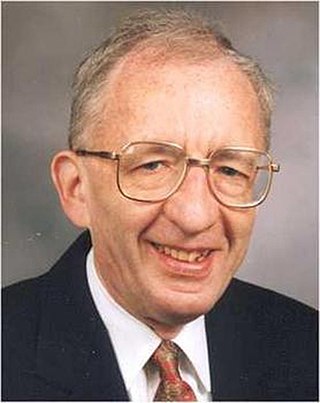
In mathematics, the Euclidean algorithm, or Euclid's algorithm, is an efficient method for computing the greatest common divisor (GCD) of two integers (numbers), the largest number that divides them both without a remainder. It is named after the ancient Greek mathematician Euclid, who first described it in his Elements . It is an example of an algorithm, a step-by-step procedure for performing a calculation according to well-defined rules, and is one of the oldest algorithms in common use. It can be used to reduce fractions to their simplest form, and is a part of many other number-theoretic and cryptographic calculations.
A pseudorandom sequence of numbers is one that appears to be statistically random, despite having been produced by a completely deterministic and repeatable process. Simply put, the problem is that many of the sources of randomness available to humans rely on physical processes not readily available to computer programs.
Catalan's conjecture (or Mihăilescu's theorem) is a theorem in number theory that was conjectured by the mathematician Eugène Charles Catalan in 1844 and proven in 2002 by Preda Mihăilescu at Paderborn University. The integers 23 and 32 are two perfect powers (that is, powers of exponent higher than one) of natural numbers whose values (8 and 9, respectively) are consecutive. The theorem states that this is the only case of two consecutive perfect powers. That is to say, that

In number theory, the study of Diophantine approximation deals with the approximation of real numbers by rational numbers. It is named after Diophantus of Alexandria.
In mathematics, a low-discrepancy sequence is a sequence with the property that for all values of N, its subsequence x1, ..., xN has a low discrepancy.

In numerical analysis, the quasi-Monte Carlo method is a method for numerical integration and solving some other problems using low-discrepancy sequences to achieve variance reduction. This is in contrast to the regular Monte Carlo method or Monte Carlo integration, which are based on sequences of pseudorandom numbers.
In number theory, a formula for primes is a formula generating the prime numbers, exactly and without exception. No such formula which is efficiently computable is known. A number of constraints are known, showing what such a "formula" can and cannot be.
In mathematics, a Pisot–Vijayaraghavan number, also called simply a Pisot number or a PV number, is a real algebraic integer greater than 1, all of whose Galois conjugates are less than 1 in absolute value. These numbers were discovered by Axel Thue in 1912 and rediscovered by G. H. Hardy in 1919 within the context of diophantine approximation. They became widely known after the publication of Charles Pisot's dissertation in 1938. They also occur in the uniqueness problem for Fourier series. Tirukkannapuram Vijayaraghavan and Raphael Salem continued their study in the 1940s. Salem numbers are a closely related set of numbers.
In mathematics, the Stoneham numbers are a certain class of real numbers, named after mathematician Richard G. Stoneham (1920–1996). For coprime numbers b, c > 1, the Stoneham number αb,c is defined as
In mathematics, a sequence (s1, s2, s3, ...) of real numbers is said to be equidistributed, or uniformly distributed, if the proportion of terms falling in a subinterval is proportional to the length of that subinterval. Such sequences are studied in Diophantine approximation theory and have applications to Monte Carlo integration.

Transcendental number theory is a branch of number theory that investigates transcendental numbers, in both qualitative and quantitative ways.
Inversive congruential generators are a type of nonlinear congruential pseudorandom number generator, which use the modular multiplicative inverse to generate the next number in a sequence. The standard formula for an inversive congruential generator, modulo some prime q is:

Arithmetica is an Ancient Greek text on mathematics written by the mathematician Diophantus in the 3rd century AD. It is a collection of 130 algebraic problems giving numerical solutions of determinate equations and indeterminate equations.
In number theory, Dirichlet's theorem on Diophantine approximation, also called Dirichlet's approximation theorem, states that for any real numbers and , with , there exist integers and such that and

Per H. Enflo is a Swedish mathematician working primarily in functional analysis, a field in which he solved problems that had been considered fundamental. Three of these problems had been open for more than forty years:
In computational number theory and computational algebra, Pollard's kangaroo algorithm is an algorithm for solving the discrete logarithm problem. The algorithm was introduced in 1978 by the number theorist John M. Pollard, in the same paper as his better-known Pollard's rho algorithm for solving the same problem. Although Pollard described the application of his algorithm to the discrete logarithm problem in the multiplicative group of units modulo a prime p, it is in fact a generic discrete logarithm algorithm—it will work in any finite cyclic group.
In mathematics, specifically the area of Diophantine approximation, the Davenport–Schmidt theorem tells us how well a certain kind of real number can be approximated by another kind. Specifically it tells us that we can get a good approximation to irrational numbers that are not quadratic by using either quadratic irrationals or simply rational numbers. It is named after Harold Davenport and Wolfgang M. Schmidt.

Alan Baker was an English mathematician, known for his work on effective methods in number theory, in particular those arising from transcendental number theory.
In number theory, specifically in Diophantine approximation theory, the Markov constant of an irrational number is the factor for which Dirichlet's approximation theorem can be improved for .
In mathematics, a nilsequence is a type of numerical sequence playing a role in ergodic theory and additive combinatorics. The concept is related to nilpotent Lie groups and almost periodicity. The name arises from the part played in the theory by compact nilmanifolds of the type where is a nilpotent Lie group and a lattice in it.











